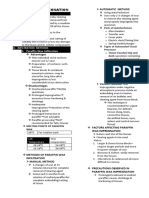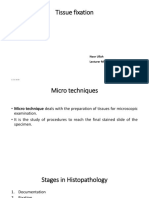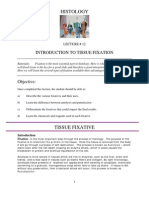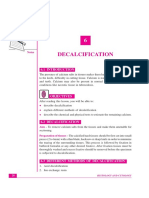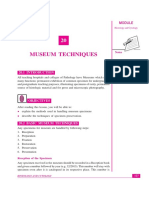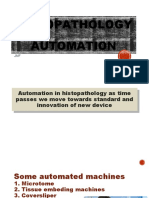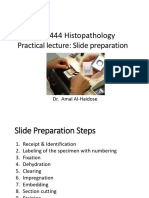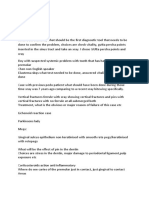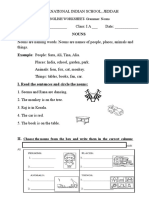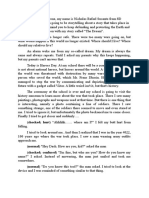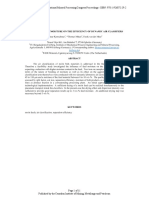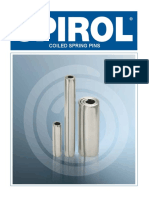Introduction to
Histopathology
�What is HISTOPATHOLOGY
Histo – Tissue
Pathos – disease suffering
Refers to the microscopic examination of tissue in order to study
the manifestation of disease.
Histopathology refers to the examination of a biopsy or surgical
specimen by a pathologist.
After the specimen has been processed and histological sections
have been placed onto glass slides.
� Histopathology is the department of clinical lab which deals with
the study of different types of tissues.
Steps in Basic Histology Techniques:
Before the specimen can be examined in this way a number of
steps are usually needed. In the case of a histopathology
specimen, after removal from a patient, the tissue undergoes the
following steps:
1. Receipt and Identification
2. Labelling of the specimen with numbering
3. Fixation
4. Clearing
5. Impregnation
6. Section and cutting
7. Staining
8. Mounting
�Specimen identification and
labelling
Tissue specimen received in the surgical pathology laboratory have
a request form that lists the patient information and history along
with a description of the site of origin.
The specimen are accessioned by giving them a number that will
identify each specimen for each patient.
�Fixation
This is the process by which the constituents of cells and tissue are
fixed in a physical and chemical state so that they will withstand
subsequent treatment with various reagents with minimum loss of
architecture.
This achieved by exposing the tissue to chemical compounds, call
fixatives.
�Mechanism of action of Fixatives
Most fixatives act by denaturing or precipitating proteins which
then form a sponge or meshwork, tending to hold the other
constituents.
Good fixatives is most important factors in the production of
satisfactory results in histopathology.
Following factors are important :
a. Fresh tissue
b. Proper penetration of tissue by fixatives
c. Correct choice of fixatives
No fixatives will penetrate a piece of tissue thicker than 1 cm.
For dealing with specimen thicker than this, following methods
are recommended:
�1. Solid organ
Cut slices as necessary as but not thicker than 5mm.
2. Hollow organ
Either open or fill with fixatives or pack lightly with wool soaked
in fixatives.
3. Large specimen
It requires dissection, Inject fixative along the vessels or bronchi
as in case of lung so that it reaxhes all parts of the organs.
�Properties of an Ideal Fixative
Prevents autolysis and bacterial decomposition.
Preserves tissue in their natural state and fix all components.
Make the cellular components insoluble to reagent used in tissue
processing.
Presreves tissue volume.
Avoid excessive hardness of tissue.
Allows enhanced staining of tissue
Should be non toxic and non allergic for users.
Should not be very expenssive
�Temperature
The fixation can be carried out at room temperature.
Tissue should not be frozen once it has been placed in the
fixatives solutions, for a peculiar ice crystals distortion will result.
SPEED OF FIXATION:
The speed of fixation of most fixatives is almost 1mm/hour.
Therefore, a fixation time of several hours is needed for most
specimens.
AMOUNT OF FIXATIVES FLUID:
This should be approximately 10-20 times the volume of the
specimen.
Fixatives should surround the specimen on all sides.
�Factors affecting fixation
Size and thickness of piece of tissue.
Tissue covered by large amount of mucous fix slowly.
Tissue covered by blood or organ containing very large amount of
blood also fix slowly.
Fixation is accelerated by agitation.
Fixation is accelerated by maintaining temperature around 60
degrees Celsius.
�Classification of Fixatives
Classified into three categories:
1. Tissue fixatives
2. Cytological fixatives
3. Histochemical fixatives
Tissue fixatives:
Buffered formalin
Buffered glutaraldehyde
Zenker’s formal saline
Bowen’s fluid
� Cytological fixatives:
Ethanol
Methanol
Ether
Histochemical fixatives:
Formal saline
Cold acetone
Absolute alcohol
���Tissue Processing
In order to cut thin sections of the tissues, it should have suitable
hardness and consistency when presented to the knife edge.
These properties can be imparted by infiltrating and surrounding
the tissue with paraffin wax, colliding or low viscosity
nitrocellulose, various types of resins or by freezing.
This process is called tissue processing.
It requires 24 hours and done in many stages.
It can be subdivided into:
a. Dehydration
b. Clearing
c. Impregnating
d. Embedding
It is important that all specimens are properly labeled before
processing is started.
�Types of tissue processing
There are two types:
1. Manual Tissue Processing
2. Mechanical Tissue Processing
Manual Tissue Processing
In this process the tissue is changed from one container of reagent to
another by hand.
Mechanical Tissue Processing
In this the tissue is moved from one jar to another by mechanical
device.
Timings are controlled by a timer which can be adjusted in respect to
hours and minutes.
Temperature is maintained around 60oC.
The processing whether manually or mechanically, involves the same
steps and reagents in the same sequence.
�Sequence of Tissue Processing
Dehydration
Tissues are dehydrated by using strength of alcohol; eg. 50%, 70%,
90% and 100%.
The duration for which tissues are kept in each strength of alcohol
depends upon the size of tissue, fixative used and type of tissue.
Delicate tissue will get high degree of shrinkage by two great
concentration of alcohol.
The volume of alcohol should be 50-100 times that of tissue.
Clearing
During dehydration water in tissue has been replaced by alcohol.
The next step alcohol should be replaced by paraffin wax.
As paraffin wax is not alcohol soluble, we replace alcohol with a
substance in which wax is soluble. This step is call clearing.
� Clearing of tissue is achieved by any of the followingreagents:
Xylene
Chloroform
Benzene
Carbon tetrachloride
Toluene
Note:
Xylene is commonly used. Small piece of tissue are cleaned in
0.5- 1 hour.
Whereas larger (5cm or more thick) are cleared in 2-4 hours.
�Impregnation with Wax
This is allowed to occur at melting point temperature of paraffin wax,
which is 54-60oC. Volume of wax should be about 25-30 times the
volume of tissues.
The duration of impregnation depends on size and types of tissues and
the clearing agents employed.
Longer periods are required for larger pieces and also for harder tissue
like bones and skin as compared to liver, kidney, spleen and lung etc.
Total duration of 4 hoirs is sufficient for routine impregnation.
Paraffin wax is used routinely. It has hard consistency, so section of 3-4
micron thickness can be out.
Types of wax employed for Impregnation:
Paraffin wax
Water soluble wax
Other material, like colloidin, gelatin, paraplast
�Embedding
Impregnated tissues are placed in a mold with their labels and
then fresh melted wax is poured in it and allowed to settle and
solidify.
Once the block has cooled sufficiently it is cut into individual
blocks and each is trimmed.
Labels are made to adhere on the surface of the block by melting
the wax with a metal strips sufficiently warmed.
�Microtomy
For light microscopy, a glass knife mounted in a microtome is
used to cut 4-6 um- thick tissue sections which are mounted on a
glass microscope slide.
For transmission electron microscopy, a diamond knife
mounted in an ultramicrotome is used to cut 50nm- thick tissue
sections which are mounted on a 3mm diameter copper grid.
Then the mounted sections are treated with the appropriate
stain.
Frozen tissue embedded in a freezing medium is cut on a
microtome in a cooled machine called a cryostat.
��Staining
Staining is a process by which we give color to a section.
There are hundreds of stain available.
Classification of Stains:
Acid stain
Basic stain
Neutral stain
��Acid Dyes
In an acid dye the basic component is colored and the acid
component is colorless.
Acid dyes stain basic components e.g. eosin stain cytoplasm
The color imparted is shade of red
BASIC DYES
In a basic dyes the acid component is colored and the basic
component is colorless.
Basic dyes stain acidic components e.g. basic fuschin stain
nucleus
The color imparted is shade of blue
��Neutral Dyes
When an acid dye is combined with a basic dye a neutral dye is
formed.
As it contains both colored radicals, it gives different colors to
cytoplasm and nucleus simultaneously.
This is the basis of Leishman stain.
Special Stains
When a specific components of tissue e.g. firous tissue, elastic
tissue, nuclear material is to be stained, certain special stains are
used which specifically stain that component tissue.
�Procedure of staining
There are two types of staining:
1. Manual staining
2. Automatic staining
Manual Staining
In a small laboratory when a few slide are stained daily, this is
the method of choice.
Different reagent containers are placed in a special sequence and
the slides are removed from one container to another manually.
��Automatic Staining
In this procedure an automatic stainer is required.
It has a timer, which controls the time.
It has a mechanical device which shifts the slides from one
container to next after the specified time.
Advantages of automated stainer are:
It reduces the man power
It controls the timing of staining accurately.
Large number of slides can be stained simultaneously
Less reagents are used
Notes: Slides stained either manually or by automatic stainer, pass
through same sequences.














